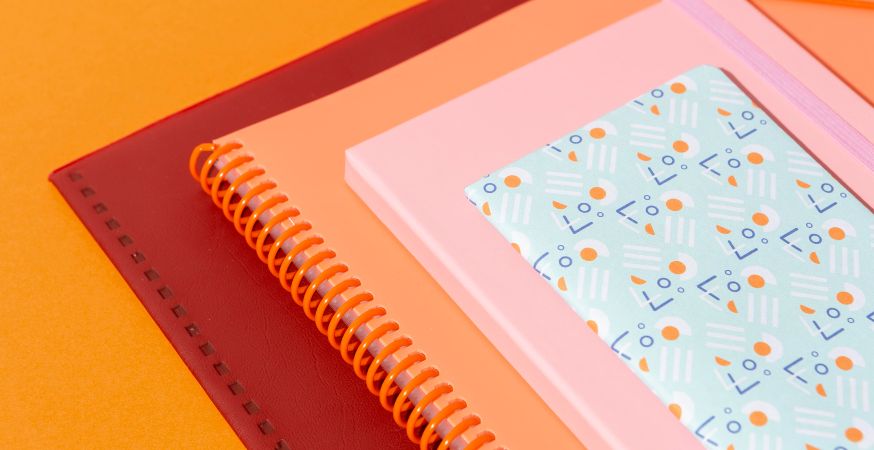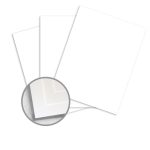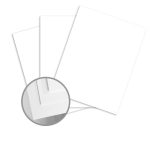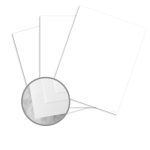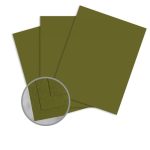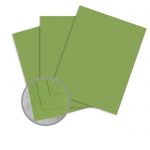When planning a printed piece, selecting the right binding paper is about more than just aesthetics—it’s a crucial part of the structural design. The physical characteristics of your paper, from grain direction to caliper and coating, all directly impact how well a paper stock will perform with different types of binding.
Each binding option has unique requirements. For example:
- Paper with the wrong grain direction can crack or resist folding during booklet binding methods like saddle stitch.
- Coated stocks may need scoring or special adhesives to work with perfect binding.
- Heavier cover stocks, if not properly prepared, can create alignment or finishing issues with coil or Wire-O binding.
In this guide, we’ll walk through the most common binding options used in print and explore how specific paper properties, such as weight, finish, flexibility, and print compatibility, affect their success. We’ll explore:
Jump To:
Whether you’re creating a short-run booklet, a catalog, or a custom-bound piece, matching the right paper to the right binding method ensures your project looks polished and performs as intended.
Let’s dive in.
Why Paper Compatibility Matters for Binding
When planning a multi-page print piece, understanding the relationship between binding paper and the types of binding you use is critical. Each binding option, from saddle stitch to perfect binding, applies different mechanical forces to the paper, which can affect both production quality and the final user experience.
Choosing the wrong paper for your book or booklet binding can lead to issues like cracking at the spine, warping, or even binding failure. That’s why it’s essential to evaluate how the paper’s weight, grain direction, and finish interact with your selected binding method.
Here’s why paper compatibility matters across different binding options:
- Mechanical stress: Certain types of binding, like spiral or Wire-O, require papers that are flexible enough to be punched without tearing, while others need stock that folds cleanly or holds adhesive well.
- Grain direction: The grain should typically run parallel to the spine. Ignoring grain direction means the pages may resist folding, crack along the seam, or warp after trimming.
- Coatings and surface texture: Coated or glossy papers may not adhere properly in glue-based binding styles unless the surface is prepped correctly. Rough finishes may also pose challenges in automated bindery equipment.
- Paper bulk and caliper: Total page thickness affects what binding options are viable for a specific paper stock. For instance, saddle stitch works best for booklets under 64 pages, while thicker projects may require perfect binding or coil.
- Ink and print performance: Not all papers handle duplex printing or ink drying the same way—factors that directly impact how well your binding paper performs in booklet or catalog production.
The key to successful booklet binding is selecting paper that complements the method, not just aesthetically but functionally. In the next section, we’ll break down common types of binding and recommend paper traits that ensure the best results for each.
Common Binding Methods & Compatible Paper Types
Understanding the most widely used types of binding can help you choose the best binding paper for your project. Each binding option requires specific paper characteristics to ensure structural integrity, print performance, and a professional finish.
Below, we’ll break down the most common booklet binding and document binding methods, along with guidance on the types of paper that work best with each.
Saddle Stitch Binding
How It Works: Folded sheets nested and stapled along the spine
Best For: Booklets, brochures, programs (typically under 64 pages)
Paper Compatibility Tips:
- Use lightweight text-weight paper (60–80 lb) for interior pages to minimize bulk and ensure a clean fold.
- Choose cover stocks around 80–100 lb cover for durability. Just make sure to score heavier papers to prevent spine cracking.
- Always ensure the grain direction runs parallel to the fold to avoid warping or cracking.
Look for offset or uncoated stocks that fold easily and print cleanly on both sides—ideal for saddle-stitched booklet binding.
Perfect Binding
How It Works: Pages are stacked and glued at the spine with a wraparound cover
Best For: Magazines, catalogs, softcover books
Paper Compatibility Tips:
- Use opaque interior text-weight papers (70–100 lb) to prevent show-through
- Select 100 lb or heavier cover stocks for strength and visual appeal—just be sure to score the spine
- Ensure coated papers are glue-compatible, or roughen the spine edges to improve adhesion
- Consider paper caliper (thickness) to ensure a strong spine and smooth trimming
Look for coated or uncoated binding paper that pairs flexibility with structural integrity, such as these:
Spiral (Coil) Binding
How It Works: Holes are punched along the binding edge, and a plastic coil is threaded through
Best For: Workbooks, manuals, calendars
Paper Compatibility Tips:
- Use durable, mid-weight text papers (70–100 lb) that resist tearing
- Avoid very stiff or thick sheets that may not punch cleanly
- Select smooth or lightly textured finishes for better performance in punch equipment
You’ll need a paper that can handle frequent page turns and lay flat—ideal for high-use binding options.
Wire-O Binding
How It Works: A double-loop wire is inserted through punched holes for a polished look
Best For: Presentations, planners, high-end booklets
Paper Compatibility Tips:
- Choose binding paper that holds up well around punched holes
- Pair flexible text stocks for interiors with heavier cover papers (up to 130 lb)
- Both coated and uncoated papers work—just ensure they have clean punching and page-turning ability
Opt for a smooth, tear-resistant paper with a professional finish.
Smyth Sewn Binding
How It Works: Folded signatures (sections of pages) are sewn together with thread along the spine and typically case-bound with a hard cover
Best For: Hardcover books, archival publications, fine art books
Paper Compatibility Tips:
- Use flexible, high-quality text-weight papers (70–100 lb) that can fold cleanly without cracking
- Grain direction must run parallel to the spine for smooth page turns and durability
- Avoid very heavy or coated stocks that resist folding or stitching
Use an acid-free or archival-quality uncoated binding paper that supports long-term use and structural integrity.
Swiss Binding
How It Works: Similar in appearance to perfect binding, but with a visible spine; the interior text block is glued to the inside back cover, leaving the spine exposed or partially revealed
Best For: Design-forward softcover books, brand books, portfolios
Paper Compatibility Tips:
- Interior papers should be durable and flexible (e.g., 70–100 lb text stock) to accommodate the lay-flat effect
- Cover stocks should have visual or tactile appeal so the Swiss binding can highlights the construction
- Coated papers may need scoring or finishing adjustments depending on thickness
Look for unique or textured binding paper for covers and smooth, flexible interior sheets to complement the exposed spine aesthetic.
Case Binding (Hardcover Binding)
How It Works: The interior text block is typically Smyth sewn or perfect bound, then glued into a rigid case made of board wrapped in printed paper, cloth, or specialty materials.
Best For: Hardcover books, coffee table books, archival publications
Paper Compatibility Tips:
- Use flexible text-weight binding paper (70–100 lb) for interior pages to ensure clean folding and smooth opening.
- Ensure grain direction runs parallel to the spine for proper lay-flat performance.
- End sheets (used to attach the text block to the case) are often heavier and should be chosen to match or complement the cover design.
- Avoid overly glossy stocks that may not adhere well during casing-in.
Choose acid-free, archival-quality binding paper for long-lasting durability, especially for premium or collectible editions.
Tape Binding
How It Works: A thermally activated adhesive tape is wrapped around the spine, often over stitched or glued interior pages, to form a flat, professional edge.
Best For: Legal documents, academic reports, business manuals
Paper Compatibility Tips:
- Use consistent text-weight paper (20–28 lb bond or 70–100 lb text) for best alignment and adhesion.
- Avoid textured or coated stocks that may interfere with the bond between the tape and the paper.
- Be precise with trimming—tape binding leaves little room for misalignment.
Smooth, uncoated stocks with uniform thickness work best for this binding option.
Comb Binding
How It Works: Rectangular holes are punched along the spine edge of the pages, and a flexible plastic comb is inserted to hold them together.
Best For: Office presentations, training manuals, school projects
Paper Compatibility Tips:
- Select tear-resistant text-weight paper (around 70–90 lb) to handle the punching and page-turning process.
- Avoid very stiff or coated stocks, which can jam punching equipment or tear at the holes.
- Comb binding allows for easy page replacement, so papers should maintain dimensional stability over time.
Use durable, uncoated binding paper for reliable performance and ease of handling.
3 Common Paper Mistakes That Undermine Binding
Even the most carefully chosen binding option can fall short if you use the wrong binding paper for the job. From structural issues to visual flaws, paper-related mistakes can lead to production problems, added costs, and disappointing results.
Below are three of the most common paper-related mistakes designers and printers make when planning for different types of binding—and how to avoid them.
1. Ignoring grain direction
Why It Matters: Grain direction affects how paper folds, bends, and responds to mechanical processes like stitching, gluing, and punching. For most book or booklet binding methods, the grain should run parallel to the spine.
What Can Go Wrong:
- Cracking or splitting at the spine during folding or scoring
- Warped pages that don’t lie flat
- Increased stress on adhesives or stitches
How To Avoid It: Always verify grain direction before printing. Many binding paper products are available in both long grain and short grain formats. Choose the one that aligns best with your layout.
2. Choosing paper that’s too thick or too stiff
Why It Matters: Overly thick or rigid paper can interfere with folding, punching, or gluing, especially in automated bindery equipment. While heavier stocks can look and feel impressive, they’re not always compatible with all binding options.
What Can Go Wrong:
- Bulky spines that won’t hold staples or glue
- Jammed punching dies in spiral or comb binding
- Covers that crack or misalign after trimming
How To Avoid It: Balance visual impact with mechanical performance. For interior pages, stick to flexible text weights unless the binding method specifically allows for heavier stock.
3. Using coated or textured papers without finishing prep
Why It Matters: Coated, glossy, or textured papers may resist adhesives, crease poorly, or challenge punch precision. These finishes can be beautiful, but they often require additional finishing steps to work with certain types of binding.
What Can Go Wrong:
- Glue doesn’t adhere in perfect or Swiss binding
- Coated covers crack at the spine if not scored
- Punch holes tear in textured stocks
How To Avoid It: Use scoring and surface prep techniques when working with heavy or specialty papers. If you’re not sure if a paper will work for your binding method, do a test print with paper samples or speak to your printer or paper supplier before committing to a stock.
PAPER PRO TIP: Our low-cost paper samples make it easy to test how your selected stock performs with your chosen booklet binding method. You’ll get a better sense of print quality, flexibility, and finish—without committing to a full order upfront.
How to Choose Paper for Your Bound Project
Once you’ve selected your binding style, it’s time to choose a binding paper that both supports your design vision and performs well during production. Whether you’re planning a short-run booklet binding or a long-format publication, thoughtful paper selection ensures your final piece looks polished and functions as intended.
Here are key factors to consider when evaluating binding paper for your project:
1. Start with function first
Will the project be heavily handled (e.g., workbooks, manuals) or stored long-term (e.g., reports, catalogs)?
Choose paper weights and finishes that match your durability needs—flexible text stocks for interiors, and heavier cover stocks where needed.
2. Match paper to your binding method
Make sure your paper choice matches your binding method’s requirements, and avoid paper types that conflict with your production specs:
- Grain direction should always parallel to the spine
- Flexibility for folding, gluing, or punching
- Adhesive compatibility for perfect or Swiss binding
3. Consider finish and print quality
Uncoated papers offer a soft, tactile feel—great for legibility and writing—while coated papers provide sharper image reproduction, especially for photo-heavy projects.
Textured papers can also add visual interest but may affect ink holdout and punchability.
4. Request samples before you commit
Even small differences in paper texture, thickness, or stiffness can make a big impact on the finished product. Testing ahead of time helps you avoid common issues and choose with confidence.
📦 Need to test before you print? We offer low-cost paper samples so you can evaluate print performance, color, and compatibility with your chosen binding type—before committing to a full run.
Pair the Right Paper with the Right Binding for Better Results
The success of your printed piece doesn’t just depend on design or layout—it hinges on how well your paper and binding option work together. From saddle stitch to Swiss binding, every method has unique requirements when it comes to paper flexibility, weight, and finish. Choosing the wrong paper for your binding style can lead to cracking, misalignment, or even complete bindery failure.
Whether you’re printing a product catalog, a branded booklet, or an art book, we’re here to help.
Explore our wide selection of papers compatible with all major types of binding—and don’t forget to request affordable samples so you can test your design before you print.
🛒 Ready to find your perfect paper?
Browse our full range of text and cover stocks, or order samples today to start planning with confidence.

